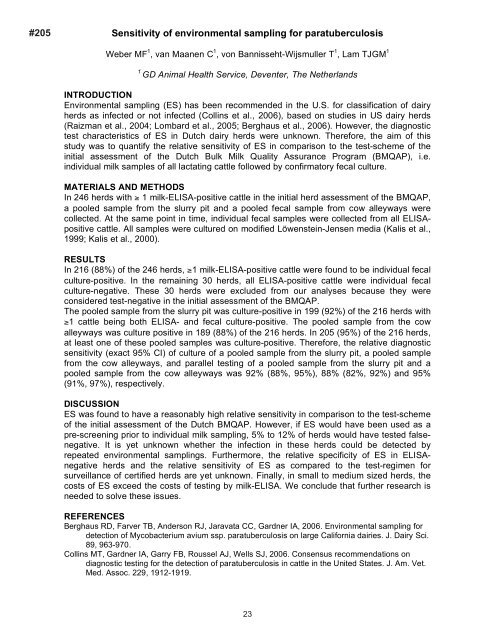Proceedings of the 10th International Colloquium on Paratuberculosis
Proceedings of the 10th International Colloquium on Paratuberculosis
Proceedings of the 10th International Colloquium on Paratuberculosis
Create successful ePaper yourself
Turn your PDF publications into a flip-book with our unique Google optimized e-Paper software.
#205<br />
Sensitivity <str<strong>on</strong>g>of</str<strong>on</strong>g> envir<strong>on</strong>mental sampling for paratuberculosis<br />
Weber MF 1 , van Maanen C 1 , v<strong>on</strong> Bannisseht-Wijsmuller T 1 , Lam TJGM 1<br />
1 GD Animal Health Service, Deventer, The Ne<str<strong>on</strong>g>the</str<strong>on</strong>g>rlands<br />
INTRODUCTION<br />
Envir<strong>on</strong>mental sampling (ES) has been recommended in <str<strong>on</strong>g>the</str<strong>on</strong>g> U.S. for classificati<strong>on</strong> <str<strong>on</strong>g>of</str<strong>on</strong>g> dairy<br />
herds as infected or not infected (Collins et al., 2006), based <strong>on</strong> studies in US dairy herds<br />
(Raizman et al., 2004; Lombard et al., 2005; Berghaus et al., 2006). However, <str<strong>on</strong>g>the</str<strong>on</strong>g> diagnostic<br />
test characteristics <str<strong>on</strong>g>of</str<strong>on</strong>g> ES in Dutch dairy herds were unknown. Therefore, <str<strong>on</strong>g>the</str<strong>on</strong>g> aim <str<strong>on</strong>g>of</str<strong>on</strong>g> this<br />
study was to quantify <str<strong>on</strong>g>the</str<strong>on</strong>g> relative sensitivity <str<strong>on</strong>g>of</str<strong>on</strong>g> ES in comparis<strong>on</strong> to <str<strong>on</strong>g>the</str<strong>on</strong>g> test-scheme <str<strong>on</strong>g>of</str<strong>on</strong>g> <str<strong>on</strong>g>the</str<strong>on</strong>g><br />
initial assessment <str<strong>on</strong>g>of</str<strong>on</strong>g> <str<strong>on</strong>g>the</str<strong>on</strong>g> Dutch Bulk Milk Quality Assurance Program (BMQAP), i.e.<br />
individual milk samples <str<strong>on</strong>g>of</str<strong>on</strong>g> all lactating cattle followed by c<strong>on</strong>firmatory fecal culture.<br />
MATERIALS AND METHODS<br />
In 246 herds with � 1 milk-ELISA-positive cattle in <str<strong>on</strong>g>the</str<strong>on</strong>g> initial herd assessment <str<strong>on</strong>g>of</str<strong>on</strong>g> <str<strong>on</strong>g>the</str<strong>on</strong>g> BMQAP,<br />
a pooled sample from <str<strong>on</strong>g>the</str<strong>on</strong>g> slurry pit and a pooled fecal sample from cow alleyways were<br />
collected. At <str<strong>on</strong>g>the</str<strong>on</strong>g> same point in time, individual fecal samples were collected from all ELISApositive<br />
cattle. All samples were cultured <strong>on</strong> modified Löwenstein-Jensen media (Kalis et al.,<br />
1999; Kalis et al., 2000).<br />
RESULTS<br />
In 216 (88%) <str<strong>on</strong>g>of</str<strong>on</strong>g> <str<strong>on</strong>g>the</str<strong>on</strong>g> 246 herds, �1 milk-ELISA-positive cattle were found to be individual fecal<br />
culture-positive. In <str<strong>on</strong>g>the</str<strong>on</strong>g> remaining 30 herds, all ELISA-positive cattle were individual fecal<br />
culture-negative. These 30 herds were excluded from our analyses because <str<strong>on</strong>g>the</str<strong>on</strong>g>y were<br />
c<strong>on</strong>sidered test-negative in <str<strong>on</strong>g>the</str<strong>on</strong>g> initial assessment <str<strong>on</strong>g>of</str<strong>on</strong>g> <str<strong>on</strong>g>the</str<strong>on</strong>g> BMQAP.<br />
The pooled sample from <str<strong>on</strong>g>the</str<strong>on</strong>g> slurry pit was culture-positive in 199 (92%) <str<strong>on</strong>g>of</str<strong>on</strong>g> <str<strong>on</strong>g>the</str<strong>on</strong>g> 216 herds with<br />
�1 cattle being both ELISA- and fecal culture-positive. The pooled sample from <str<strong>on</strong>g>the</str<strong>on</strong>g> cow<br />
alleyways was culture positive in 189 (88%) <str<strong>on</strong>g>of</str<strong>on</strong>g> <str<strong>on</strong>g>the</str<strong>on</strong>g> 216 herds. In 205 (95%) <str<strong>on</strong>g>of</str<strong>on</strong>g> <str<strong>on</strong>g>the</str<strong>on</strong>g> 216 herds,<br />
at least <strong>on</strong>e <str<strong>on</strong>g>of</str<strong>on</strong>g> <str<strong>on</strong>g>the</str<strong>on</strong>g>se pooled samples was culture-positive. Therefore, <str<strong>on</strong>g>the</str<strong>on</strong>g> relative diagnostic<br />
sensitivity (exact 95% CI) <str<strong>on</strong>g>of</str<strong>on</strong>g> culture <str<strong>on</strong>g>of</str<strong>on</strong>g> a pooled sample from <str<strong>on</strong>g>the</str<strong>on</strong>g> slurry pit, a pooled sample<br />
from <str<strong>on</strong>g>the</str<strong>on</strong>g> cow alleyways, and parallel testing <str<strong>on</strong>g>of</str<strong>on</strong>g> a pooled sample from <str<strong>on</strong>g>the</str<strong>on</strong>g> slurry pit and a<br />
pooled sample from <str<strong>on</strong>g>the</str<strong>on</strong>g> cow alleyways was 92% (88%, 95%), 88% (82%, 92%) and 95%<br />
(91%, 97%), respectively.<br />
DISCUSSION<br />
ES was found to have a reas<strong>on</strong>ably high relative sensitivity in comparis<strong>on</strong> to <str<strong>on</strong>g>the</str<strong>on</strong>g> test-scheme<br />
<str<strong>on</strong>g>of</str<strong>on</strong>g> <str<strong>on</strong>g>the</str<strong>on</strong>g> initial assessment <str<strong>on</strong>g>of</str<strong>on</strong>g> <str<strong>on</strong>g>the</str<strong>on</strong>g> Dutch BMQAP. However, if ES would have been used as a<br />
pre-screening prior to individual milk sampling, 5% to 12% <str<strong>on</strong>g>of</str<strong>on</strong>g> herds would have tested falsenegative.<br />
It is yet unknown whe<str<strong>on</strong>g>the</str<strong>on</strong>g>r <str<strong>on</strong>g>the</str<strong>on</strong>g> infecti<strong>on</strong> in <str<strong>on</strong>g>the</str<strong>on</strong>g>se herds could be detected by<br />
repeated envir<strong>on</strong>mental samplings. Fur<str<strong>on</strong>g>the</str<strong>on</strong>g>rmore, <str<strong>on</strong>g>the</str<strong>on</strong>g> relative specificity <str<strong>on</strong>g>of</str<strong>on</strong>g> ES in ELISAnegative<br />
herds and <str<strong>on</strong>g>the</str<strong>on</strong>g> relative sensitivity <str<strong>on</strong>g>of</str<strong>on</strong>g> ES as compared to <str<strong>on</strong>g>the</str<strong>on</strong>g> test-regimen for<br />
surveillance <str<strong>on</strong>g>of</str<strong>on</strong>g> certified herds are yet unknown. Finally, in small to medium sized herds, <str<strong>on</strong>g>the</str<strong>on</strong>g><br />
costs <str<strong>on</strong>g>of</str<strong>on</strong>g> ES exceed <str<strong>on</strong>g>the</str<strong>on</strong>g> costs <str<strong>on</strong>g>of</str<strong>on</strong>g> testing by milk-ELISA. We c<strong>on</strong>clude that fur<str<strong>on</strong>g>the</str<strong>on</strong>g>r research is<br />
needed to solve <str<strong>on</strong>g>the</str<strong>on</strong>g>se issues.<br />
REFERENCES<br />
Berghaus RD, Farver TB, Anders<strong>on</strong> RJ, Jaravata CC, Gardner IA, 2006. Envir<strong>on</strong>mental sampling for<br />
detecti<strong>on</strong> <str<strong>on</strong>g>of</str<strong>on</strong>g> Mycobacterium avium ssp. paratuberculosis <strong>on</strong> large California dairies. J. Dairy Sci.<br />
89, 963-970.<br />
Collins MT, Gardner IA, Garry FB, Roussel AJ, Wells SJ, 2006. C<strong>on</strong>sensus recommendati<strong>on</strong>s <strong>on</strong><br />
diagnostic testing for <str<strong>on</strong>g>the</str<strong>on</strong>g> detecti<strong>on</strong> <str<strong>on</strong>g>of</str<strong>on</strong>g> paratuberculosis in cattle in <str<strong>on</strong>g>the</str<strong>on</strong>g> United States. J. Am. Vet.<br />
Med. Assoc. 229, 1912-1919.<br />
23






